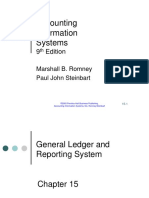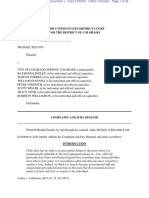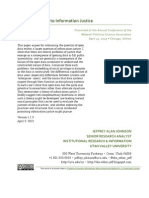Overview of Business Processes: Accounting Information Systems, 9/e, Romney/Steinbart
Overview of Business Processes: Accounting Information Systems, 9/e, Romney/Steinbart
Uploaded by
Asfaw WossenCopyright:
Available Formats
Overview of Business Processes: Accounting Information Systems, 9/e, Romney/Steinbart
Overview of Business Processes: Accounting Information Systems, 9/e, Romney/Steinbart
Uploaded by
Asfaw WossenOriginal Title
Copyright
Available Formats
Share this document
Did you find this document useful?
Is this content inappropriate?
Copyright:
Available Formats
Overview of Business Processes: Accounting Information Systems, 9/e, Romney/Steinbart
Overview of Business Processes: Accounting Information Systems, 9/e, Romney/Steinbart
Uploaded by
Asfaw WossenCopyright:
Available Formats
Overview of
Business Processes
Chapter 2
©2003 Prentice Hall Business Publishing, 2-1
Accounting Information Systems, 9/e, Romney/Steinbart
Basic Functions of AIS
AIS can perform its three basic
functions :
1. To collect and store data about the organization’s
business activities and transactions efficiently and
effectively
2 To provide information useful for decision making
3 To provide adequate controls to ensure that data
are recorded and processed accurately
©2003 Prentice Hall Business Publishing, 2-2
Accounting Information Systems, 9/e, Romney/Steinbart
The Three Basic Functions
Performed by an AIS
1 To collect and store data about the
organization’s business activities and
transactions efficiently and effectively:
Capture transaction data on source
documents.
Record transaction data in journals, which
present a chronological record of what
occurred.
Post data from journals to ledgers, which
sort data by account type.
©2003 Prentice Hall Business Publishing, 2-3
Accounting Information Systems, 9/e, Romney/Steinbart
The Three Basic Functions
Performed by an AIS
2 To provide management with
information useful for decision
making:
In manual systems, this information is
provided in the form of reports that fall
into two main categories:
– financial statements
– managerial reports
©2003 Prentice Hall Business Publishing, 2-4
Accounting Information Systems, 9/e, Romney/Steinbart
The Three Basic Functions
Performed by an AIS
3 To provide adequate internal controls:
Ensure that the information produced
by the system is reliable.
Ensure that business activities are
performed efficiently and in
accordance with management’s
objectives.
Safeguard organizational assets.
©2003 Prentice Hall Business Publishing, 2-5
Accounting Information Systems, 9/e, Romney/Steinbart
Basic Subsystems in the AIS
1. The revenue cycle: involves activities of
selling goods or services and collecting
payment for those sales.
2. The expenditure cycle: involves activities
of buying and paying for goods or
services used by the organization.
3. The human resources/payroll cycle:
involves activities of hiring and paying
employees.
©2003 Prentice Hall Business Publishing, 2-6
Accounting Information Systems, 9/e, Romney/Steinbart
Basic Subsystems in the AIS
4. The production cycle: involves activities
converting raw materials and labor into
finished goods.
5. The financing cycle: involves activities
of obtaining necessary funds to run the
organization, repay creditors, and
distribute profits to investors.
©2003 Prentice Hall Business Publishing, 2-7
Accounting Information Systems, 9/e, Romney/Steinbart
Basic Subsystems in the AIS
Financing Expenditure Human
Cycle Cycle Resources
General Ledger & Reporting System
Production Revenue
Cycle Cycle
©2003 Prentice Hall Business Publishing, 2-8
Accounting Information Systems, 9/e, Romney/Steinbart
The Data Processing Cycle
The data processing cycle consists
of four steps:
1. Data input
2. Data storage
3. Data processing
4. Information Output
©2003 Prentice Hall Business Publishing, 2-9
Accounting Information Systems, 9/e, Romney/Steinbart
The Data Processing Cycle
The trigger for data input is usually
business activity. Data must be
collected about:
1. Each event of interest
2. The resources affected by each
event
3. The agents who participate in each
event
©2003 Prentice Hall Business Publishing, 2-10
Accounting Information Systems, 9/e, Romney/Steinbart
Data Processing Cycle:
Data Input
Historically, most businesses used
paper source documents to collect
data and then transferred that data
into a computer.
Today, most data are recorded
directly through data entry screens.
©2003 Prentice Hall Business Publishing, 2-11
Accounting Information Systems, 9/e, Romney/Steinbart
Data Processing Cycle:
Data Input
Control over data collection is
improved by:
prenumbering each source document
and using turnaround documents
having the system automatically
assign a sequential number to each
new transaction
employing source data automation
©2003 Prentice Hall Business Publishing, 2-12
Accounting Information Systems, 9/e, Romney/Steinbart
Common Source
Documents and Functions
REVENUE CYCLE
Source Document Function
Sales order Take customer order.
Delivery ticket Deliver or ship order
Remittance advice Receive cash.
Deposit slip Deposit cash receipts.
Credit memo Adjust customer accounts
©2003 Prentice Hall Business Publishing, 2-13
Accounting Information Systems, 9/e, Romney/Steinbart
Common Source
Documents and Functions
EXPENDITURE CYCLE
Source Document Function
Purchase requisition Request items.
Purchase order Order items.
Receiving report Receive items.
Check Pay for items.
©2003 Prentice Hall Business Publishing, 2-14
Accounting Information Systems, 9/e, Romney/Steinbart
Common Source
Documents and Functions
HUMAN RESOURCES CYCLE
Source Document Function
W4 forms Collect employee
withholding data.
Time cards Record time worked
by employees.
Job time tickets Record time spent
on specific jobs.
©2003 Prentice Hall Business Publishing, 2-15
Accounting Information Systems, 9/e, Romney/Steinbart
Common Source
Documents and Functions
GENERAL LEDGER AND
REPORTING SYSTEM
Source Document Function
Journal voucher Record entry posted to
general ledger.
©2003 Prentice Hall Business Publishing, 2-16
Accounting Information Systems, 9/e, Romney/Steinbart
Data Processing Cycle:
Data Processing
Batch processing is the periodic
updating of the data stored about
resources and agents
On-line, real-time processing is the
immediate updating as each
transaction occurs
©2003 Prentice Hall Business Publishing, 2-17
Accounting Information Systems, 9/e, Romney/Steinbart
Data Processing Cycle:
Data Storage
An entity is something about which
information is stored.
Each entity has attributes or
characteristics of interest, which need
to be stored.
©2003 Prentice Hall Business Publishing, 2-18
Accounting Information Systems, 9/e, Romney/Steinbart
Record Transaction Data
in Journals
After transaction data have been
captured on source documents, the
next step is to record the data in a
journal.
A journal entry is made for each
transaction showing the accounts and
amounts to be debited and credited.
©2003 Prentice Hall Business Publishing, 2-19
Accounting Information Systems, 9/e, Romney/Steinbart
Record Transaction Data
in Journals
The general journal records infrequent
or nonroutine transactions.
Specialized journals simplify the
process of recording large numbers of
repetitive transactions.
What are the four most common types
of transactions?
©2003 Prentice Hall Business Publishing, 2-20
Accounting Information Systems, 9/e, Romney/Steinbart
Record Transaction Data
in Journals
1 Credit sales
2 Cash receipts
3 Purchases on account
4 Cash disbursements
©2003 Prentice Hall Business Publishing, 2-21
Accounting Information Systems, 9/e, Romney/Steinbart
Record Transaction Data
in Journals
Page 5 Sales Journal
Invoice Account Account Post
Date Number Debited Number Ref. Amount
Dec. 1 201 Lee Co. 120-122 3 800.00
Dec. 1 202 May Co. 120-033 3 700.00
Dec. 1 203 DLK Co. 120-111 3 900.00
TOTAL: 2,400.00
120/502
©2003 Prentice Hall Business Publishing, 2-22
Accounting Information Systems, 9/e, Romney/Steinbart
Post Transactions to
Ledgers
Ledgers are used to summarize the
financial status, including the current
balance, of individual accounts.
The general ledger contains
summary-level data for every asset,
liability, equity, revenue, and expense
account of an organization.
©2003 Prentice Hall Business Publishing, 2-23
Accounting Information Systems, 9/e, Romney/Steinbart
Post Transactions to
Ledgers
A subsidiary ledger records all the
detailed data for any general ledger
account that has many individual
subaccounts.
What are some commonly used
subsidiary ledgers?
– accounts receivable
– inventory
– accounts payable
©2003 Prentice Hall Business Publishing, 2-24
Accounting Information Systems, 9/e, Romney/Steinbart
Post Transactions to
Ledgers
What is the general ledger account
corresponding to a subsidiary ledger
called?
– control account
A control account contains the total
amount for all individual accounts in
the subsidiary ledger.
©2003 Prentice Hall Business Publishing, 2-25
Accounting Information Systems, 9/e, Romney/Steinbart
Post Transactions to Ledgers
Sales Journal Page 5
Date Invoice Account Account Post Amount
Number Debited Number Ref.
Dec 1 203 DLK Co. 120-111 3 900.00
Total 2,400.00
120/502
General Ledger
Account: Accounts Receivable Account Number: 120
Date Description Post Ref. Debit Credit Balance
Dec 1 Sales SJ5 2,400 2,400
©2003 Prentice Hall Business Publishing, 2-26
Accounting Information Systems, 9/e, Romney/Steinbart
What is the
Chart of Accounts?
The chart of accounts is a list of all
general ledger accounts used by an
organization.
It is important that the chart of
accounts contains sufficient detail to
meet the information needs of the
organization.
©2003 Prentice Hall Business Publishing, 2-27
Accounting Information Systems, 9/e, Romney/Steinbart
Providing Information for
Decision Making
The second function of the AIS is to
provide management with information
useful for decision making.
The information an AIS provides falls
into two main categories:
Financial Statements
Managerial Reports
©2003 Prentice Hall Business Publishing, 2-28
Accounting Information Systems, 9/e, Romney/Steinbart
Financial Statements
Prepare a trial balance.
Make adjusting entries.
Prepare the adjusted trial balance.
Produce the income statement.
Make closing entries.
Produce the balance sheet.
Prepare the statement of cash flows.
©2003 Prentice Hall Business Publishing, 2-29
Accounting Information Systems, 9/e, Romney/Steinbart
Managerial Reports
The AIS must also be able to provide
managers with detailed operational
information about the organization’s
performance.
Two important types of managerial
reports are
– budget
– performance reports
©2003 Prentice Hall Business Publishing, 2-30
Accounting Information Systems, 9/e, Romney/Steinbart
Managerial Reports
What is a budget?
A budget is the formal expression of
goals in financial terms.
One of the most common types of
budget is a cash budget.
©2003 Prentice Hall Business Publishing, 2-31
Accounting Information Systems, 9/e, Romney/Steinbart
Managerial Reports
What is a performance report?
A performance report lists the
budgeted and actual amounts of
revenues and expenses and also
shows the variances, or differences,
between these two amounts.
©2003 Prentice Hall Business Publishing, 2-32
Accounting Information Systems, 9/e, Romney/Steinbart
Managerial Reports
Magic Co. Monthly Performance Report
Budget Actual Variance
Sales $32,400 $31,500 ($900)
Cost of Goods 12,000 14,000 (2,000)
Gross Margin $20,400 $17,500 ($2,900)
Other Expenses 9,000 7,000 2,000
Operating Income $11,400 $10,500 ($900)
©2003 Prentice Hall Business Publishing, 2-33
Accounting Information Systems, 9/e, Romney/Steinbart
Internal Control
Considerations
The third function of an AIS is to
provide adequate internal controls to
accomplish three basic objectives:
1 Ensure that the information is reliable.
2 Ensure that business activities are
performed efficiently.
3 Safeguard organizational assets.
©2003 Prentice Hall Business Publishing, 2-34
Accounting Information Systems, 9/e, Romney/Steinbart
Internal Control
Considerations
What are two important methods for
accomplishing these objectives?
1 Provide for adequate documentation
of all business activities.
2 Design the AIS for effective
segregation of duties.
©2003 Prentice Hall Business Publishing, 2-35
Accounting Information Systems, 9/e, Romney/Steinbart
Adequate Documentation
Documentation allows management to
verify that assigned responsibilities
were completed correctly.
What did Ashton encounter while
working as an auditor that gave him a
firsthand glimpse of the types of
problems that can arise from
inadequate documentation?
– failure to bill for repair work
©2003 Prentice Hall Business Publishing, 2-36
Accounting Information Systems, 9/e, Romney/Steinbart
What is
Segregation of Duties?
Segregation of duties refers to
dividing responsibility for different
portions of a transaction among
several people.
What functions should be performed
by different people?
– authorizing transactions
– recording transactions
– maintaining custody of assets
©2003 Prentice Hall Business Publishing, 2-37
Accounting Information Systems, 9/e, Romney/Steinbart
You might also like
- ITIL® Guide to Software and IT Asset Management - Second EditionFrom EverandITIL® Guide to Software and IT Asset Management - Second EditionRating: 1 out of 5 stars1/5 (1)
- Release Form ArtworkDocument1 pageRelease Form ArtworkmikiNo ratings yet
- Accounting Information Systems: 9 EditionDocument49 pagesAccounting Information Systems: 9 Editionjeff4509No ratings yet
- Accounting Information Systems: 9 EditionDocument48 pagesAccounting Information Systems: 9 Editionanonim sayaNo ratings yet
- Accounting Information Systems: 9 EditionDocument48 pagesAccounting Information Systems: 9 EditionNoreen Jean RamosNo ratings yet
- RevenueCycle WhiteDocument162 pagesRevenueCycle WhiteMariam MahmoudNo ratings yet
- TranslateDocument41 pagesTranslateMicela ZuntNo ratings yet
- ACC 311 - Topic 3 - The General LedgerDocument46 pagesACC 311 - Topic 3 - The General Ledgerjoyce plandNo ratings yet
- Chapter 9Document61 pagesChapter 9SILVIANA PUTRINo ratings yet
- A Is 11Document53 pagesA Is 11fiona313800No ratings yet
- Ais CH 3Document114 pagesAis CH 3Lakachew GetasewNo ratings yet
- Business Process MappingDocument80 pagesBusiness Process MappingNeel DigeNo ratings yet
- General Ledger and Reporting SystemDocument44 pagesGeneral Ledger and Reporting SystemVia ZuñigaNo ratings yet
- Accounting Information Systems: 9 EditionDocument43 pagesAccounting Information Systems: 9 EditionfaiqalikhanNo ratings yet
- AIS Ch-3Document105 pagesAIS Ch-3bati86548No ratings yet
- Accounting Information Systems: 9 EditionDocument45 pagesAccounting Information Systems: 9 Editionangeline_andreaNo ratings yet
- AIS Ch-2Document114 pagesAIS Ch-2Meklit AlemNo ratings yet
- Ais CH 1Document112 pagesAis CH 1Lakachew GetasewNo ratings yet
- 1.3 Systems Development and Documentation Techniques_138Document114 pages1.3 Systems Development and Documentation Techniques_138Zemera TradingNo ratings yet
- 1.7 Accounting System and Business ProcessesDocument116 pages1.7 Accounting System and Business ProcessesZemera TradingNo ratings yet
- AIS Romney 2006 Slides 03 Systems Development and Documentation TechniquesDocument138 pagesAIS Romney 2006 Slides 03 Systems Development and Documentation Techniquessharingnotes12350% (2)
- Romney Ch03Document114 pagesRomney Ch03samsul arifinNo ratings yet
- Irsyadillah Romney Ais11 Inppt03 PDFDocument50 pagesIrsyadillah Romney Ais11 Inppt03 PDFNelsi KhairunnisaNo ratings yet
- Ch5Document11 pagesCh5giminaalphaNo ratings yet
- The Human Resources Management/Payroll Cycle: Accounting Information Systems 9 EditionDocument52 pagesThe Human Resources Management/Payroll Cycle: Accounting Information Systems 9 Editionaprian0% (1)
- Romney Ab - Az.ch02 UploadDocument112 pagesRomney Ab - Az.ch02 UploadHafni ZahraNo ratings yet
- Hapter 2Document112 pagesHapter 2Waya LapianNo ratings yet
- AIS01Document49 pagesAIS01Fitriyah Az-zahraaNo ratings yet
- DFD FlowchartDocument114 pagesDFD FlowchartNatasya SherllNo ratings yet
- AIS04 Relational DatabasesDocument40 pagesAIS04 Relational DatabasesKris Zyl Faith LaiNo ratings yet
- Accounting Information Systems: 9 EditionDocument55 pagesAccounting Information Systems: 9 EditionRhoda Mae AlbaNo ratings yet
- Hapter 10: © 2008 Prentice Hall Business Publishing Accounting Information Systems, 11/e Romney/SteinbartDocument134 pagesHapter 10: © 2008 Prentice Hall Business Publishing Accounting Information Systems, 11/e Romney/SteinbartSyed HasanNo ratings yet
- Romney Ch02Document112 pagesRomney Ch02Maryjane YaranonNo ratings yet
- Chapter 2: Overview of Business ProcessDocument16 pagesChapter 2: Overview of Business ProcessZoe McKenzieNo ratings yet
- Module 3 & 4 - Business Accounting 2001Document24 pagesModule 3 & 4 - Business Accounting 2001Archill YapparconNo ratings yet
- Accounting Information Systems: 9 EditionDocument58 pagesAccounting Information Systems: 9 EditionAmeliaErfaNo ratings yet
- Transaction Processing and Enterprise Resource Planning SystemsDocument32 pagesTransaction Processing and Enterprise Resource Planning SystemsShaheen Mahmud0% (1)
- 02 - Transaction Processing and ERP SystemsDocument24 pages02 - Transaction Processing and ERP Systemsashleykiki.keNo ratings yet
- Romney Chapter 2 Kelompok 9 SIADocument38 pagesRomney Chapter 2 Kelompok 9 SIANorman Dwi PrasetyoNo ratings yet
- AIS Romney 2006 Slides 10 The Revenue CycleDocument161 pagesAIS Romney 2006 Slides 10 The Revenue Cyclesharingnotes123100% (2)
- Hapter 1: Accounting Information Systems: An OverviewDocument39 pagesHapter 1: Accounting Information Systems: An OverviewJoanne_Choong_2179No ratings yet
- Rais11 ch02Document112 pagesRais11 ch02theresiaaaaaNo ratings yet
- AIS Romney 2006 Slides 02 Business ProcessDocument119 pagesAIS Romney 2006 Slides 02 Business Processsharingnotes123100% (1)
- AIS Week 1 RS2Document21 pagesAIS Week 1 RS2Michael OktavianusNo ratings yet
- Chapter 03Document60 pagesChapter 03Benny Supriyadi SiregarNo ratings yet
- Lecture 02Document111 pagesLecture 02UnknownNo ratings yet
- Accounting Information Systems: An OverviewDocument85 pagesAccounting Information Systems: An OverviewEleven Schienza Uno100% (1)
- Hapter 10: © 2008 Prentice Hall Business Publishing Accounting Information Systems, 11/e Romney/SteinbartDocument134 pagesHapter 10: © 2008 Prentice Hall Business Publishing Accounting Information Systems, 11/e Romney/SteinbartRoristua PandianganNo ratings yet
- AIS Lesson2Document37 pagesAIS Lesson2Belleza AndreaNo ratings yet
- AIS Week 2 RS3Document66 pagesAIS Week 2 RS3Raisa AnggrainiNo ratings yet
- Chapter 2 ReportDocument101 pagesChapter 2 ReportRia BagoNo ratings yet
- Accounting Information Systems - Overview of Business ProcessesDocument75 pagesAccounting Information Systems - Overview of Business ProcessesDr Rushen SinghNo ratings yet
- The Data Warehouse Toolkit: The Complete Guide to Dimensional ModelingFrom EverandThe Data Warehouse Toolkit: The Complete Guide to Dimensional ModelingRating: 4 out of 5 stars4/5 (30)
- Bookkeeping And Accountancy Made Simple: For Owner Managed Businesses, Students And Young EntrepreneursFrom EverandBookkeeping And Accountancy Made Simple: For Owner Managed Businesses, Students And Young EntrepreneursNo ratings yet
- Data Entry: A Guide to Data Entry Operations That Make Money OnlineFrom EverandData Entry: A Guide to Data Entry Operations That Make Money OnlineNo ratings yet
- Accounting Policies and Procedures Manual: A Blueprint for Running an Effective and Efficient DepartmentFrom EverandAccounting Policies and Procedures Manual: A Blueprint for Running an Effective and Efficient DepartmentNo ratings yet
- Doing Business 2016: Measuring Regulatory Quality and EfficiencyFrom EverandDoing Business 2016: Measuring Regulatory Quality and EfficiencyRating: 5 out of 5 stars5/5 (1)
- Data Entry Operator: Skills, Software, Career Tips, and Interview Q&AFrom EverandData Entry Operator: Skills, Software, Career Tips, and Interview Q&ANo ratings yet
- Project Information Document Ethiopia Digital Foundations Project P171034Document20 pagesProject Information Document Ethiopia Digital Foundations Project P171034Asfaw Wossen100% (1)
- Thesis Format 1.1. Formatting Requirements: Approved Writing StyleDocument5 pagesThesis Format 1.1. Formatting Requirements: Approved Writing StyleAsfaw WossenNo ratings yet
- Talent ManagementDocument1 pageTalent ManagementAsfaw WossenNo ratings yet
- Top 14 Interview PHD QuestionDocument2 pagesTop 14 Interview PHD QuestionAsfaw Wossen100% (1)
- ReferencesDocument9 pagesReferencesAsfaw WossenNo ratings yet
- Smart SocietyDocument34 pagesSmart SocietyAsfaw WossenNo ratings yet
- Chapter ThreeDocument61 pagesChapter ThreeAsfaw WossenNo ratings yet
- MBA Case StudyDocument10 pagesMBA Case StudyAsfaw WossenNo ratings yet
- E-Commerce and Electronic Payment SystemDocument57 pagesE-Commerce and Electronic Payment SystemAsfaw WossenNo ratings yet
- Ethiopian Tax SystemDocument26 pagesEthiopian Tax SystemAsfaw WossenNo ratings yet
- IAS 21 The Effects of Changes in Foreign Exchange RatesDocument7 pagesIAS 21 The Effects of Changes in Foreign Exchange RatesAsfaw WossenNo ratings yet
- July 2020 Lawsuit: Michael Sexton v. City of Colorado Springs, Et Al.Document28 pagesJuly 2020 Lawsuit: Michael Sexton v. City of Colorado Springs, Et Al.Michael_Roberts2019No ratings yet
- Classroom Program Sy2023-2024Document2 pagesClassroom Program Sy2023-2024Verzie PuralNo ratings yet
- Blockchain Technology, Bitcoin, and Ethereum: A Brief OverviewDocument8 pagesBlockchain Technology, Bitcoin, and Ethereum: A Brief OverviewjohnNo ratings yet
- Chapter 1 ThesisDocument8 pagesChapter 1 ThesisCarizza Grace CassandraNo ratings yet
- Pariyerum Perumal On The Caste Reality oDocument4 pagesPariyerum Perumal On The Caste Reality oishraf908No ratings yet
- A Sample Micro Winery Business Plan TemplateDocument13 pagesA Sample Micro Winery Business Plan Templatecvw0% (1)
- Joshua Phua-ResumeDocument2 pagesJoshua Phua-ResumeAlbaroziraNo ratings yet
- Winning Over Our BattlesDocument24 pagesWinning Over Our BattlesJundell DiazNo ratings yet
- Uganda Contingent Commander Brigadier General Sam Kavuma Concludes One Year Tour of Duty in SomaliaDocument3 pagesUganda Contingent Commander Brigadier General Sam Kavuma Concludes One Year Tour of Duty in SomaliaAMISOM Public Information ServicesNo ratings yet
- Parte de Renzo, Fatima, Xime, Diana, AndreaDocument7 pagesParte de Renzo, Fatima, Xime, Diana, AndreajosefabricioNo ratings yet
- English LiteratureDocument9 pagesEnglish LiteratureSai TamaNo ratings yet
- Exchange Client DeveloperDocument5,901 pagesExchange Client Developerpcitest123No ratings yet
- Volt Report Chapter3Document11 pagesVolt Report Chapter3VishalNo ratings yet
- Digikala-Ramin Shabanpour (2016)Document19 pagesDigikala-Ramin Shabanpour (2016)Ramin ShabNo ratings yet
- v2 I2 (2) A008Document6 pagesv2 I2 (2) A008PrateekNo ratings yet
- 5e1db40f5caa2749a7501267 - STS - PROTECH - Gun Mount BrochureDocument2 pages5e1db40f5caa2749a7501267 - STS - PROTECH - Gun Mount BrochurePanthep PattongNo ratings yet
- Unbelievable Macho BullshitDocument2 pagesUnbelievable Macho BullshitNadel OrrevasNo ratings yet
- Mid-Year Review Form (MRF) For Teacher I-IiiDocument11 pagesMid-Year Review Form (MRF) For Teacher I-IiiAling Alena100% (3)
- Negotiable Instrument Act No 2031 184-198Document2 pagesNegotiable Instrument Act No 2031 184-198Elena TanNo ratings yet
- From Open Data To Information JusticeDocument21 pagesFrom Open Data To Information JusticeTomás AguerreNo ratings yet
- AI Writing Critique TechniquesDocument19 pagesAI Writing Critique Techniquesdon_h_manzanoNo ratings yet
- Attendance Sheet Data PrivacyDocument11 pagesAttendance Sheet Data PrivacyDivina Grace Rodriguez - LibreaNo ratings yet
- 20242005571640vacancy Announcement Tutorial Assistant OutDocument7 pages20242005571640vacancy Announcement Tutorial Assistant OutAhmed AllyNo ratings yet
- Customer Segments and Store Format For Tanishq: Section-BDocument14 pagesCustomer Segments and Store Format For Tanishq: Section-BVISHESH MAHESHWARINo ratings yet
- Economic of Soil ErosionDocument30 pagesEconomic of Soil ErosionHehlangki TyngkanNo ratings yet
- Daftar PustakaDocument2 pagesDaftar PustakaGilbert Sterling OctaviusNo ratings yet
- Product Lifecycle Management Introductory GuideDocument52 pagesProduct Lifecycle Management Introductory GuideAditya Soumava75% (4)
- Millat TractorsDocument16 pagesMillat TractorsNoman AmjadNo ratings yet
- STS The Good Life ReviewerDocument2 pagesSTS The Good Life ReviewerCorinne Bautista RenivaNo ratings yet




































































































